Direct Payment System
(Switzerland)
Direktzahlungssystem
Description
Financial aid of the government to land users to compensate for loss of financial output of crops.
Aims / objectives: The main aim is to maintain agriculture and its production of goods. Because of the small amount of financial output for a land user and its products in Switzerland, there are direct payments to the land user paid per area size. These payments are substantial for every land user but especially in mountain regions of Switzerland to compensate land users for their work for nature and environment. Another goal is to keep the nutrient security of Switzerland alive. This goal can only be reached by supplementary payments in order to produce agricultural goods competitively.
Methods: Direct payments mean financial sums paid to a land user per area size. They differ from position of the field. A land user must apply for the direct payments in autumn. During winter the land user must mark his fields and their use online. Payments are reached three times during the following year: in June, autumn and winter.
Stages of implementation: The beginning of direct payments is in the 1980s when there were payments for livestock owners. Before there were never direct financial payments to land users but the agricultural products were financed by the government itself and land users got a fixed price for their products. 1989 land users got direct payments for the first time under the programs IP Suisse and ÖLN. Today payments are calculated by area size.
Role of stakeholders: The direct payment system is mainly a political issue. Politicians make budgets for the total amount of direct payments each year. Moreover, they can make new rules and obligations for land users. The land user must always adopt himself and his technology and crop rotation to these changes. This can be very difficult. Land users are represented by their unions but there is no space for individual opinions or direct participation in the system.
Location

Location: Frienisberg, Bern, Switzerland
Geo-reference of selected sites
Initiation date: 1989
Year of termination: n.a.
Type of Approach
-
traditional/ indigenous
-
recent local initiative/ innovative
-
project/ programme based

-
Approach aims and enabling environment
Main aims / objectives of the approach
The Approach focused mainly on SLM with other activities (Maintenance of a good financial situation for Swiss land users)
The system wants to support Swiss Agriculture on a financial basis. Because agricultural products are produced under swiss conditions regarding wages, soil prices etc. the products can not compete against other products from abroad. The direct payments close the gap between the theoretical value of a product and its end price in stores.
The SLM Approach addressed the following problems: The system of direct payments gives wrong appeals to the land users. Because payments are made by area size land users want to expand their farm size even more. But there is also more work to do if a farm is bigger. The system also provokes cultivation of fields that are at risk for erosion or other consequences because it does not differ from fields that are at risk and fields that are not. It is only the size that matters.
Conditions enabling the implementation of the Technology/ ies applied under the Approach
Conditions hindering the implementation of the Technology/ ies applied under the Approach
-
Availability/ access to financial resources and services: Rentability of conservational agriculture and its technologies were often discussed because there may be losses at the beginning.
Treatment through the SLM Approach: Because of financial payments losses of financial capital can be compensated.
Participation and roles of stakeholders involved
Stakeholders involved in the Approach and their roles
| What stakeholders / implementing bodies were involved in the Approach? |
Specify stakeholders |
Describe roles of stakeholders |
| local land users/ local communities |
|
|
| NGO |
|
|
| local government |
|
|
| national government (planners, decision-makers) |
|
|
Lead agency
government
Involvement of local land users/ local communities in the different phases of the Approach
none
passive
external support
interactive
self-mobilization
Flow chart
Organisation chart for direct payments

Author: BLW
Decision-making on the selection of SLM Technology
Decisions were taken by
-
land users alone (self-initiative)
-
mainly land users, supported by SLM specialists
-
all relevant actors, as part of a participatory approach
-
mainly SLM specialists, following consultation with land users
-
SLM specialists alone
-
politicians/ leaders
Decisions were made based on
-
evaluation of well-documented SLM knowledge (evidence-based decision-making)
-
research findings
-
personal experience and opinions (undocumented)
Technical support, capacity building, and knowledge management
The following activities or services have been part of the approach
-
Capacity building/ training
-
Advisory service
-
Institution strengthening (organizational development)
-
Monitoring and evaluation
-
Research
Capacity building/ training
Training was provided to the following stakeholders
-
land users
-
field staff/ advisers
Form of training
-
on-the-job
-
farmer-to-farmer
-
demonstration areas
-
public meetings
-
courses
Subjects covered
There was also an overthinking on the side of land users. Some of them did not change environmentally good technologies after there were less payments for this technology because they saw the advantages of their technology. However, without a financial support at the beginning they would not have implemented new technologies.
Advisory service
Advisory service was provided
-
on land users' fields
-
at permanent centres
Advisory service is very adequate to ensure the continuation of land conservation activities
Monitoring and evaluation
bio-physical aspects were ad hoc monitored by government through observations; indicators: None
socio-cultural aspects were ad hoc monitored by government through observations; indicators: None
economic / production aspects were ad hoc monitored by government through observations; indicators: None
area treated aspects were ad hoc monitored by government through observations; indicators: None
no. of land users involved aspects were ad hoc monitored by government through measurements; indicators: None
management of Approach aspects were ad hoc monitored by None through observations; indicators: None
There were few changes in the Approach as a result of monitoring and evaluation: None
There were few changes in the Technology as a result of monitoring and evaluation: None
Research
Research treated the following topics
-
sociology
-
economics / marketing
-
ecology
-
technology
Research was carried out on station
Financing and external material support
Annual budget in USD for the SLM component
-
< 2,000
-
2,000-10,000
-
10,000-100,000
-
100,000-1,000,000
-
> 1,000,000
Precise annual budget: n.a.
Approach costs were met by the following donors: government (projects): 50.0%; national non-government (soil support program): 10.0%; local government (district, county, municipality, village etc): 40.0%
The following services or incentives have been provided to land users
-
Financial/ material support provided to land users
-
Subsidies for specific inputs
-
Credit
-
Other incentives or instruments
Financial/ material support provided to land users
partly financed
fully financed
area size
cultivation per ha
Labour by land users was
-
voluntary
-
food-for-work
-
paid in cash
-
rewarded with other material support
Impact analysis and concluding statements
Impacts of the Approach
No
Yes, little
Yes, moderately
Yes, greatly
Did the Approach help land users to implement and maintain SLM Technologies?
There are payments for conservational agriculture and technologies. Therefore, SLM is applied there. However, there are also payments for conventional agriculture and technologies and the attractiveness to change a cultivation system is not very high.
Did other land users / projects adopt the Approach?
about 97%
Main motivation of land users to implement SLM
-
increased production
-
increased profit(ability), improved cost-benefit-ratio
-
reduced land degradation
-
reduced risk of disasters
-
reduced workload
-
payments/ subsidies
-
rules and regulations (fines)/ enforcement
-
prestige, social pressure/ social cohesion
-
affiliation to movement/ project/ group/ networks
-
environmental consciousness
-
customs and beliefs, morals
-
enhanced SLM knowledge and skills
-
aesthetic improvement
-
conflict mitigation
Sustainability of Approach activities
Can the land users sustain what hat been implemented through the Approach (without external support)?
Conclusions and lessons learnt
Strengths: land user's view
-
The payments are a security of income for the land users. Therefore he continues his production of agricultural products. (How to sustain/ enhance this strength: The payment must be enough high so that it is accurate for the labour and work of a land user on the fields. This must also be a point regarding future payments.)
Strengths: compiler’s or other key resource person’s view
-
It is a fair system: a land user only gets paid for his work on a field. (How to sustain/ enhance this strength: A good life for a land user and his family is possible through the financial aid of the direct payment system. This must be maintained.)
Weaknesses/ disadvantages/ risks: land user's viewhow to overcome
-
A fixed product price would be the solution to higher payments. The situation from the beginning of the system was much better.
Product prices must be on a similar level. However, this is not possible.
Weaknesses/ disadvantages/ risks: compiler’s or other key resource person’s viewhow to overcome
-
The system provides some dependence for the land user. He can not produce competitively without supplementary payments.
Fair product prices and competitiveness would be the solution, but this is impossible to reach.
-
There are many differences during short time regarding the sum and conditions of direct payments. A land user has thereby no chance of adopting himself to the new conditions.
Payments must be stable during a longer time. Only then a land user is able to change his cultivation system.
-
The system leads to wrong cultivation of fields because a land user wants as much area size as possible. This endangers soil and can lead to erosion.
The system should be reduced to only not-endangered fields and provide payments for the non-cultivation of endangered fields.
References
Date of documentation: June 30, 2015
Last update: July 7, 2017
Resource persons
-
Deborah Niggli (deborah.niggli@cde.unibe.ch) - SLM specialist
Full description in the WOCAT database
Documentation was faciliated by
Institution
- CDE Centre for Development and Environment (CDE Centre for Development and Environment) - Switzerland
Project
- Preventing and Remediating degradation of soils in Europe through Land Care (EU-RECARE )






